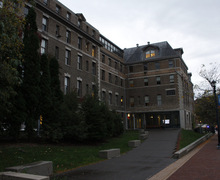Commerce, journalism interacting more and more in the fashion world
Fashion magazines are becoming more and more invested in commerce.
The purpose of fashion magazines is to ultimately have the reader purchase the items in the magazine. The magazine makes money through advertising. But since advertisers are now looking to other outlets as print journalism struggles, magazines are taking a hit.
Publishing giant Condé Nast just announced Teen Vogue is launching a clothing line with Macy’s.
In September, Harper’s Bazaar introduced ShopBazaar, a website owned by the magazine that sells accessories and apparel from the pages of Harper’s Bazaar.
In August, Lucky magazine launched MyLuckyMag.com. Just like ShopBazaar, Lucky’s commerce site sells items that are featured in the magazine. Also, in the iPad version of the magazine, you can click on any item to buy it.
In another big e-commerce push from Condé Nast, the publishing company invested $20 million in the boutique e-commerce site, Farfetch.
Many may think it’s journalistically unethical for fashion magazines to sell items from the collections they’re supposed to be covering. But as ad sales drop, more magazines are looking to other profit-making ventures, like e-commerce sites or collaborations.
So, is it a last-ditch effort to revive the struggling print industry? Or just adapting to the increasingly digital space?
On one hand, it is strange that fashion magazines are now trying to sell me things. It goes against everything I’ve ever learned about journalism ethics. But, on the other hand, I understand that as everything goes digital, magazines have to follow suit.
The phenomenon goes the other way, too: Commerce sites are becoming more editorial.
The first example I noticed was the British e-retailer, ASOS. They have a digital magazine available online and on tablets. If it weren’t for the ASOS-brand clothing and accessories in the editorials and articles, a normal reader wouldn’t realize this magazine was out of the ordinary. ASOS magazine features interviews, movie and music reviews, and fashion spreads.
Another prominent retailer that has ventured on the editorial side is Net-a-Porter. The first part of its editorial venture is its free online weekly, The Edit. They also have The Collections Special, a 300-page magazine published four to six times a year. It’s meant to compete with Vogue and Harper’s Bazaar.
Some startups are starting out with the combination of content and commerce, instead of implementing it later, like magazines and e-retailers.
The winner of Style Coalition’s Fashion 2.0 award for Best Fashion Startup, unique online retailer Of a Kind, integrated editorial content with commerce from the beginning. The site showcases products from emerging designers along with editorial content that tells the story behind each piece.
The award-winning startup shows that blending editorial with commerce is a great way to gain a solid customer base. And unlike the magazines trying to sell clothes, startups like Of a Kind don’t seem as ethically murky.
Another area of fashion that e-commerce has invaded is street style applications and personal style blogs. Street style shopping app, Kaleidoscope, lets users buy items that their favorite style bloggers wear. iPhone and iPad app, Pose, has user-generated style shots that are also shopping-capable.
All of this merging of content and commerce is a way to shorten the path from inspiration to purchase. Like most people, I read magazines for inspiration, not necessarily to go out and buy exactly what is in the spreads. With the search aspect taken out, I may be more willing to buy what I see in the pages of a magazine.
The opportunity to shop is everywhere now, from our laptops, phones and now magazines. Hopefully, this new side of magazine journalism will help save the industry. While it may go against everything journalists learn about covering the industry, fashion is a field in which we may have no other choice.
Allison Mariotti is a senior magazine journalism major. She has too many shoes to count, but could always use another pair. Her fashion column appears every Monday in Pulp. She can be reached at admariot@syr.edu.
Published on March 17, 2013 at 9:49 pm





